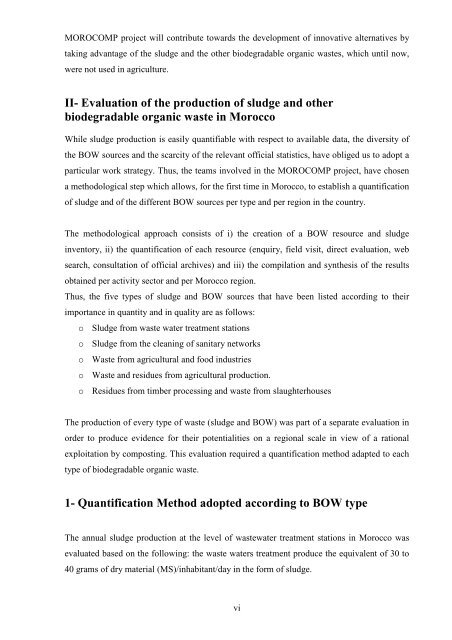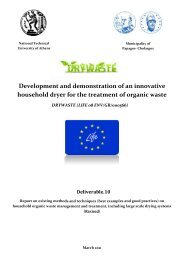morocomp (life tcy05/ma000141) - Unit of Environmental Science ...
morocomp (life tcy05/ma000141) - Unit of Environmental Science ...
morocomp (life tcy05/ma000141) - Unit of Environmental Science ...
- No tags were found...
Create successful ePaper yourself
Turn your PDF publications into a flip-book with our unique Google optimized e-Paper software.
MOROCOMP project will contribute towards the development <strong>of</strong> innovative alternatives bytaking advantage <strong>of</strong> the sludge and the other biodegradable organic wastes, which until now,were not used in agriculture.II- Evaluation <strong>of</strong> the production <strong>of</strong> sludge and otherbiodegradable organic waste in MoroccoWhile sludge production is easily quantifiable with respect to available data, the diversity <strong>of</strong>the BOW sources and the scarcity <strong>of</strong> the relevant <strong>of</strong>ficial statistics, have obliged us to adopt aparticular work strategy. Thus, the teams involved in the MOROCOMP project, have chosena methodological step which allows, for the first time in Morocco, to establish a quantification<strong>of</strong> sludge and <strong>of</strong> the different BOW sources per type and per region in the country.The methodological approach consists <strong>of</strong> i) the creation <strong>of</strong> a BOW resource and sludgeinventory, ii) the quantification <strong>of</strong> each resource (enquiry, field visit, direct evaluation, websearch, consultation <strong>of</strong> <strong>of</strong>ficial archives) and iii) the compilation and synthesis <strong>of</strong> the resultsobtained per activity sector and per Morocco region.Thus, the five types <strong>of</strong> sludge and BOW sources that have been listed according to theirimportance in quantity and in quality are as follows:o Sludge from waste water treatment stationso Sludge from the cleaning <strong>of</strong> sanitary networkso Waste from agricultural and food industrieso Waste and residues from agricultural production.o Residues from timber processing and waste from slaughterhousesThe production <strong>of</strong> every type <strong>of</strong> waste (sludge and BOW) was part <strong>of</strong> a separate evaluation inorder to produce evidence for their potentialities on a regional scale in view <strong>of</strong> a rationalexploitation by composting. This evaluation required a quantification method adapted to eachtype <strong>of</strong> biodegradable organic waste.1- Quantification Method adopted according to BOW typeThe annual sludge production at the level <strong>of</strong> wastewater treatment stations in Morocco wasevaluated based on the following: the waste waters treatment produce the equivalent <strong>of</strong> 30 to40 grams <strong>of</strong> dry material (MS)/inhabitant/day in the form <strong>of</strong> sludge.vi










